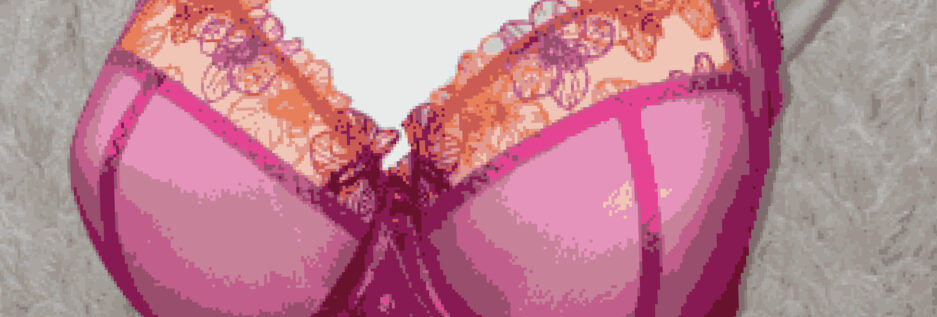Here’s a little history of my learning curve on the Omega shape.
Way back in 2012 I wrote a post called The Dawn of the Alteration Age. That was the beginning of my journey in understanding and learning about the Omega shape and the alterations needed to help fit it. In that blog I wrote:
After a few bras, I made a call to Bra-Makers Supply with a question. You see, every bra I wore, whether RTW or one I’d made, all left a line or imprint about an inch or so under the bust line. I was simply wondering what caused this.
Beverly, the owner of Bra-Makers Supply, and author of two manuals on bra-making gave me my answer: the underwires I was using were either too big or too small.
Hmm, too big or too small really wasn’t the answer I was wanting, but it did help me to realize one thing – my wires weren’t fitting. They were the same wires I’d worn in RTW bras.
So, what is the Omega shape? What is this mysterious breast shape all about? Well, I can’t say every woman with an Omega shape will be the same, but there is a common thread: the actual breast is larger than the root of the breast. If you’re wondering what that mean in terms of bra-making – it means the wire/cradle will not match the cup size. For me, I need a 36 wire/cradle, but a cup that would normally take a 42 wire/cradle.
These two sized parts don’t go together easily as they don’t match in size, so there have to be alterations to get that larger cup into that smaller cradle.
Here’s an older photo showing the different length between the two parts. The cup is on the bottom.

In this photo, you can see the cup extending out past where the cradle and the wire will end.
There are a couple of alterations to help ‘ease’ that cup into the cradle. One method that I’ve used quite a bit is to run a gathering line of stitches along the lower edge of the cup where it will fit into the cradle, then gather. You’ll have to eye-ball it a bit – gather, pin it in and see if you need to adjust the gathers or not. I tend to over-gather, so usually have to let it out a bit.

I find this method the fastest and easiest alteration. It does leave a few small puckers in the bottom of the cup, but seriously, who’s looking there?


As well, I think the puckering is a bit exaggerated on Catherine, as she’s not the same size as me. When I’m wearing the bras, I really don’t notice any puckering.
Another method of removing that excess is one I used when I first started making the alterations – I was trimming the corners of all the cup pieces to take out that inch or so of excess along the bottom of the cup. Basically making little darts all along the seams. The Shelley pattern was good for taking that excess out. But I had to be very careful – although I didn’t need the fullness at the seam line, I did all the fullness in the cup. And to be honest, it was a lot of work.

The benefit is it’s a much neater looking seam line. I’ve found it’s not worth all the fussing with the seams. I’ve found just using a little steam on the bra after I’ve sewn it really makes most of the little puckers disappear.
One last thing to consider when dealing with the Omega shape is the wires. Often a Vertical wire is recommended, and many women find that the perfect wire for them.
Here’s a great photo showing two wires that are the same size – one Vertical which is much narrower, and one is a regular long wire.

That’s quite a difference. As helpful as that Vertical wire is for many women dealing with an Omega shape – I needed more help. There’s a big difference between 36 and 42 wires. I needed both the narrower shape, but also the length and I wasn’t getting that with the smaller Vertical wires. I found Flexible wires were perfect for me.

In the above photo you can see how much narrower that Flexible wire can be. I found the Flexible wires to be perfect for me in dealing with the Omega shape. Along with the alterations I make to the cup (to help it fit into the smaller cradle), I’ve found using the Flexible wires really made a huge difference and made my bras (finally) fit me perfectly.
Happy creating!




















